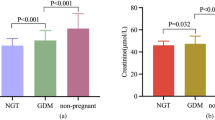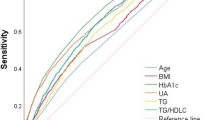Abstract
Objective
With the prevalence of obesity, growing age of first pregnancy, highly processed high-calorie diet, consumption of saturated fats as well as sedentary and stressful life, the prevalence of gestational diabetes mellitus (GDM) is increasing. We aimed to determine the predictive role of pre-pregnancy serum uric acid levels and the occurrence of GDM during pregnancy.
Methods
This study was a descriptive-analytical study that was performed retrospectively through case–control. The Subjects of this study were women over 18 years of age who were 24–28 weeks pregnant. All subjects of this study were evaluated for GDM based on the ADA guideline and were divided into case and control groups. All data relating to the period of 6 months before pregnancy of the study participants including blood uric acid level, blood pressure, etc. were collected and analyzed.
Results
In this study, 454 normal individuals without GDM and 478 others with GDM were examined. The mean serum uric acid showed to be 4.47 ± 1.33 mg/dl in patients with GDM but 3.7 ± 1.25 mg/dl in patients without GDM (p value = 0.001). The results of the regression test showed that the incidence of GDM in people with blood uric acid levels of 4.1–5, 5.1–6, and more than 6 mg/dl is 2.46, 3.42, and 4.9 times higher in people with uric acid levels less than 3 mg/dl, respectively.
Conclusion
The present study identified that serum uric acid levels in the period of 6 months before pregnancy can be used as an independent predictor marker for future GDM.
Similar content being viewed by others
Data availability
The data that support the findings of this study are available on request from the corresponding author, [Golnaz Mohammadzade]. The data are not publicly available due to the fact that they’re containing information that could compromise the privacy of research participants.
References
Association AD. Diagnosis and classification of diabetes mellitus. Diabetes Care. 2014;37(Supplement 1):S81–90.
Bellamy L, Casas J-P, Hingorani AD, Williams D. Type 2 diabetes mellitus after gestational diabetes: a systematic review and meta-analysis. The Lancet. 2009;373(9677):1773–9.
Dabelea D, Mayer-Davis EJ, Lamichhane AP, D’agostino RB, Liese AD, Vehik KS, et al. Association of intrauterine exposure to maternal diabetes and obesity with type 2 diabetes in youth: the SEARCH Case-Control Study. Diabetes Care. 2008;31(7):1422–6.
Amudha P, Nithya D, Pradeeba S, Manochithra B. Correlation between first-trimester uric acid level and subsequent development of gestational diabetes mellitus. Int J Reprod Contracept Obstet Gynecol. 2017;6(2):606–10.
Zhu Y, Zhang C. Prevalence of gestational diabetes and risk of progression to type 2 diabetes: a global perspective. Curr Diab Rep. 2016;16(1):1–11.
Eades CE, Cameron DM, Evans JM. Prevalence of gestational diabetes mellitus in Europe: a meta-analysis. Diabetes Res Clin Pract. 2017;129:173–81.
Jafari-Shobeiri M, Ghojazadeh M, Azami-Aghdash S, Naghavi-Behzad M, Piri R, Pourali-Akbar Y, et al. Prevalence and risk factors of gestational diabetes in Iran: a systematic review and meta-analysis. Iran J Public Health. 2015;44(8):1036.
Larijani B. A review of the prevalence of Gestational Diabetes Mellitus (GDM) in different regions of Iran. J Diabetes Metab Disord. 2009;8:7.
Herath H, Herath R, Wickremasinghe R. Gestational diabetes mellitus and risk of type 2 diabetes 10 years after the index pregnancy in Sri Lankan women—a community-based retrospective cohort study. PLoS ONE. 2017;12(6): e0179647.
Song C, Lyu Y, Li C, Liu P, Li J, Ma R, et al. Long-term risk of diabetes in women at varying durations after gestational diabetes: a systematic review and meta-analysis with more than 2 million women. Obes Rev. 2018;19(3):421–9.
Damm P. Future risk of diabetes in mother and child after gestational diabetes mellitus. Int J Gynecol Obstet. 2009;104:S25–6.
Reece EA. The fetal and maternal consequences of gestational diabetes mellitus. J Matern Fetal Neonatal Med. 2010;23(3):199–203.
Johns EC, Denison FC, Norman JE, Reynolds RM. Gestational diabetes mellitus: mechanisms, treatment, and complications. Trends Endocrinol Metab. 2018;29(11):743–54.
Wielandt HB, Schønemann-Rigel H, Holst CB, Fenger-Grøn J. High risk of neonatal complications in children of mothers with gestational diabetes mellitus in their first pregnancy. Dan Med J. 2015;62(6):A5093.
King H. Epidemiology of glucose intolerance and gestational diabetes in women of childbearing age. Diabetes Care. 1998;21:B9.
Solomon CG, Willett WC, Carey VJ, Rich-Edwards J, Hunter DJ, Colditz GA, et al. A prospective study of pregravid determinants of gestational diabetes mellitus. JAMA. 1997;278(13):1078–83.
Luque-Fernandez MA, Bain PA, Gelaye B, Redline S, Williams MA. Sleep-disordered breathing and gestational diabetes mellitus: a meta-analysis of 9795 participants enrolled in epidemiological observational studies. Diabetes Care. 2013;36(10):3353–60.
Thompson ML, Ananth CV, Jaddoe VW, Miller RS, Williams MA. The association of maternal adult weight trajectory with preeclampsia and gestational diabetes mellitus. Pediatric and perinatal epidemiology. 2014;28(4):287–96.
Harville EW, Juonala M, Viikari JS, Raitakari OT. Preconception metabolic indicators predict gestational diabetes and offspring birthweight. Gynecol Endocrinol. 2014;30(11):840–4.
Delissaint D, McKyer ELJ. A systematic review of factors utilized in preconception health behavior research. Health Educ Behav. 2011;38(6):603–16.
Shepherd E, Gomersall JC, Tieu J, Han S, Crowther CA, Middleton P. Combined diet and exercise interventions for preventing gestational diabetes mellitus. Cochrane Database Syst Rev. 2017;11(11):CD010443. https://doi.org/10.1002/14651858.CD010443.
Catalano P. Maternal obesity and metabolic risk to the offspring: why lifestyle interventions may have not achieved the desired outcomes. Int J Obes. 2015;39(4):642.
Pouta A, Hartikainen A-L, Sovio U, Gissler M, Laitinen J, McCarthy MI, et al. Manifestations of metabolic syndrome after hypertensive pregnancy. Hypertension. 2004;43(4):825–31.
Nakagawa T, Tuttle KR, Short RA, Johnson RJ. Hypothesis: fructose-induced hyperuricemia as a causal mechanism for the epidemic of the metabolic syndrome. Nat Rev Nephrol. 2005;1(2):80.
Masuo K, Kawaguchi H, Mikami H, Ogihara T, Tuck ML. Serum uric acid and plasma norepinephrine concentrations predict subsequent weight gain and blood pressure elevation. Hypertension. 2003;42(4):474–80.
Choi HK, Ford ES. Prevalence of the metabolic syndrome in individuals with hyperuricemia. Am J Med. 2007;120(5):442–7.
Coutinho TdA, Turner ST, Peyser PA, Bielak LF, Sheedy PF, Kullo IJ. Associations of serum uric acid with markers of inflammation, metabolic syndrome, and subclinical coronary atherosclerosis. Am J Hypertens. 2007;20(1):83–9.
Perlstein TS, Gumieniak O, Williams GH, Sparrow D, Vokonas PS, Gaziano M, et al. Uric acid and the development of hypertension: the normative aging study. Hypertension. 2006;48(6):1031–6.
Dehghan A, Van Hoek M, Sijbrands EJ, Hofman A, Witteman JC. High serum uric acid as a novel risk factor for type 2 diabetes. Diabetes Care. 2008;31(2):361–2.
Modan M, Halkin H, Karasik A, Lusky A. Elevated serum uric acid—a facet of hyperinsulinemia. Diabetologia. 1987;30(9):713–8.
Weisz B, Cohen O, Homko CJ, Schiff E, Sivan E. Elevated serum uric acid levels in gestational hypertension are correlated with insulin resistance. Am J Perinatol. 2005;22(03):139–44.
Güngör ES, Danişman N, Mollamahmutoğlu L. Relationship between serum uric acid, creatinine, albumin, and gestational diabetes mellitus. Clin Chem Lab Med (CCLM). 2006;44(8):974–7.
Anastasiou E, Lekakis JP, Alevizaki M, Papamichael CM, Megas J, Souvatzoglou A, et al. Impaired endothelium-dependent vasodilatation in women with previous gestational diabetes. Diabetes Care. 1998;21(12):2111–5.
Gill A, Kukreja S, Malhotra N, Chhabra N. Correlation of the serum insulin and the serum uric acid levels with the glycated hemoglobin levels in the patients of type 2 diabetes mellitus. J Clin Diagnostic Res. 2013;7(7):1295.
Laughon SK, Catov J, Provins T, Roberts JM, Gandley RE. Elevated first-trimester uric acid concentrations are associated with the development of gestational diabetes. Am J Obstet Gynecol. 2009;201(4):402 e1-e5.
Mohan J, Suriyamoorthi J, Menon M. Correlation of raised serum uric acid in the first trimester of pregnancy and the risk of gestational diabetes: a prospective study. Int J Reprod Contraception, Obstet Gynecol. 2017;6(8):4.
Elena IM, Tendean M, Nissi E, Darmawan G. Hyperuricemia of the pregnancy and gestational diabetes. Jurnal Kedokteran Meditek. 2019;25(3):118–21.
Khosrowbeygi A, Ahmadvand H. Serum levels of homocysteine, adiponectin and uric acid in gestational diabetes mellitus compared with normal pregnancy. Iran J Obstet Gynecol Infertil. 2017;19(38):13–23.
Wolak T, Sergienko R, Wiznitzer A, Paran E, Sheiner E. High uric acid level during the first 20 weeks of pregnancy is associated with a higher risk for gestational diabetes mellitus and mild preeclampsia. Hypertens Pregnancy. 2012;31(3):307–15.
Zhou J, Zhao X, Wang Z, Hu Y. Combination of lipids and uric acid in mid-second trimester can be used to predict adverse pregnancy outcomes. J Matern Fetal Neonatal Med. 2012;25(12):2633–8.
Kappaganthu A, Sachan J, Shailaja G. Hyperuricemia in early pregnancy: a marker for gestational diabetes mellitus. J Dental Med Sci. 2014;13(12):51–4.
Rajakumar SA, Thirumal R, Usha V, Rontgen R. Co-relation between first trimester uric acid concentration and development of gestational diabetes mellitus. J Evol Med Dent Sci. 2014;3(2):266–72.
Di Bonito P, et al. Uric acid, impaired fasting glucose and impaired glucose tolerance in youth with overweight and obesity. Nutr Metab Cardiovasc Dis. 2021;31(2):675–80.
Wang X, He H, Zhou J, Deng ZY, Li JW, Huang HJ. Association of serum uric acid with 2-hour postload glucose in prediabetic patients. Sichuan Da Xue Xue Bao Yi Xue Ban. 2015;46(5):750–3 (Chinese PMID: 26619550).
Author information
Authors and Affiliations
Corresponding author
Ethics declarations
Conflict of interest
AG, GM, MGB, and AEM declare that they have no conflict of interest.
Ethical approval
We know of no conflicts of interest associated with this publication, and there has been no significant financial support for this work that could influence its outcome. This study was presented to the ethics committee of Shahid Sadoughi University of medical science of Yazd and was approved by this committee by its ethical standards on human experimentation Ethics verification code: IR.SSU.MEDICINE.REC.1398.020 Date of approval: 3.10.2021.
Additional information
Publisher's Note
Springer Nature remains neutral with regard to jurisdictional claims in published maps and institutional affiliations.
About this article
Cite this article
Ghanei, A., Mohammadzade, G., Gholami Banadkoki, M. et al. The predictive role of serum uric acid levels before pregnancy in the development of gestational diabetes mellitus. Diabetol Int 15, 123–129 (2024). https://doi.org/10.1007/s13340-023-00662-w
Received:
Accepted:
Published:
Issue Date:
DOI: https://doi.org/10.1007/s13340-023-00662-w




